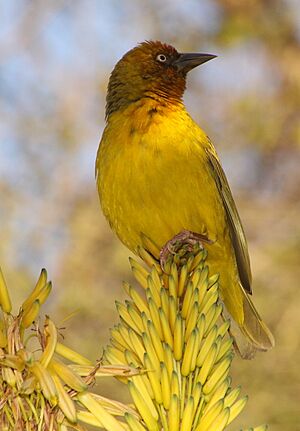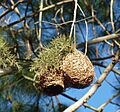Cape weaver facts for kids
Quick facts for kids Cape weaver |
|
|---|---|
 |
|
| Male in Johannesburg, South Africa | |
| Conservation status | |
| Scientific classification | |
| Synonyms | |
|
The Cape weaver (Ploceus capensis) is a type of bird in the weaver family. You can find these birds in southern Africa.
Contents
What is a Cape Weaver?
The Cape weaver is a sturdy bird, about 17 centimeters (6.7 inches) long. It has olive-brown feathers on its back with streaks. Its beak is long, pointed, and shaped like a cone.
How to Spot a Male and Female
When it's time to breed, the male Cape weaver has a bright yellow head and belly. Its face is orange, and its eyes are white.
Adult female Cape weavers have an olive-yellow head and chest. Their lower belly is a lighter yellow. Females usually have brown eyes. Young birds look similar to the females.
What Sounds Do They Make?
The Cape weaver's song is a loud, sizzling sound. When it senses danger, it makes a sharp, double "chip" call. For contact, it uses a harsh "azwit" sound.
Where Do Cape Weavers Live?
Cape weavers live only in South Africa, Lesotho, and Eswatini. They are found in many parts of these countries, but not in the dry Kalahari Desert. They live from the Orange River in the north down to the Cape of Good Hope and east to northern KwaZulu Natal.
These birds like open grasslands, coastal bushes, and farmlands. They need places with water and trees. In hotter, drier areas, they stick to higher lands. They never live in thick forests.
How Do Cape Weavers Behave?
When not breeding, Cape weavers gather in large groups. They often share roosting spots with other birds, including different types of weavers. Sometimes, they leave their breeding areas and return when the next breeding season starts.
Cape weavers have been seen "anting." This is when a bird rubs ants on its feathers. They also enjoy bathing, even in rain or mist.
Building Nests and Raising Chicks
Cape weavers are colonial nesters. This means many males build nests close together. Each male can have up to seven female partners in one breeding season. Males usually form colonies with 2 to 20 other males.
Each male builds several nests in his small area. He protects his nests strongly from other males. Females check the nests by pulling at the material inside. If a nest is good, the female shows she is ready to mate.
The male builds the nest in about a week. It's shaped like a kidney and is waterproof. He uses wide strips of grass or reeds, weaving them together. Once a female accepts a nest, the male adds an entrance tunnel at the bottom. The female then lines the inside with fine grass and feathers.
Nests are often attached to the end of tree branches, like eucalyptus or willow trees. They can also be built in tall wetland plants, on power lines, or on fences near water.
A female lays 2 to 5 eggs. Eggs are laid from June to February, with most laid between October and January. The female sits on the eggs for about two weeks. After the chicks hatch, she keeps them warm for the first few nights. Later, she sleeps in an empty nest nearby. At first, only the female feeds the chicks. But as they grow, the males help more with feeding. Young birds leave the nest when they are about 17 days old.
Sometimes, other birds like the diederik cuckoo lay their eggs in Cape weaver nests. This is called "brood parasitism." Old Cape weaver nests can also be used by Cape sparrows and African dusky flycatchers.
What Do They Eat?
Cape weavers eat both animals and plants. Their diet is split evenly between things like insects and plant matter such as seeds, fruit, and nectar. They find food in many ways: on the ground, in tree leaves, by picking food off bark, and by catching insects in the air.
Their long beak helps them eat many different foods. They eat various insects, spiders, seeds, nectar, and fruit. Female Cape weavers seem to have a more varied diet than males. Cape weavers are important pollinators for aloe plants in South Africa.
Are They in Danger?
The Cape weaver is not a threatened bird. In fact, it is very common. Sometimes, they can be a problem in fruit orchards and farms in the Western Cape. Because of this, they are sometimes killed in large numbers.
Gallery
-
A nest built of pine needles, at Harrismith, Free State




